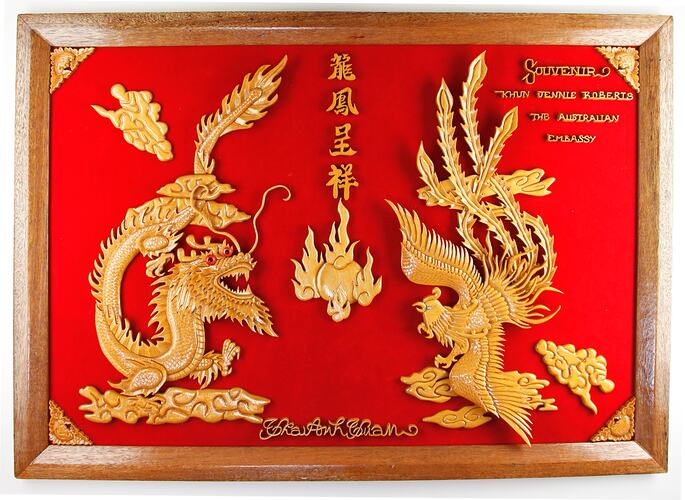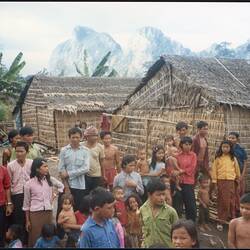Summary
Framed wood carving, presented to Jennie Roberts, Senior Migration Officer with the Australian Department of Immigration, as a token of appreciation for the Australian Government's program of accepting refugees from Indo China. It was a gift from Thai Anh Tuan, a Vietnamese refugee whom Jennie processed for migration to Australia in Phan Nikhom Camp, Thailand, in1988, along with other refugee interpreters Jennie had worked with on a number of interview trips. Mr Tuan probably commissioned the making of such carvings and collected 'donations' to cover the cost of materials and workmanship.It may have been produced by a fellow refugee in the camp where he was awaiting the finalisation of his application with his family. While waiting, Mr Tuan volunteered with the Australian [and probably American and Canadian] interview teams as an interpreter at Phanat Nikhom Camp, work vital to enabling migration officers interview and assess the eligibility of applicants. Mr Tuan had several children and their departure for Australia in the latter part of 1988 was delayed due to his wife suffering an illness.
Jennie Roberts was posted as a Senior Migration Officer to Bangkok in Thailand from 1987 to 1989, when Australia had an extensive program for south-east Asian refugee and humanitarian entrants, primarily from Vietnam, Laos and Cambodia. Based in the Visa Office at the Australian Embassy, Jennie and her colleagues frequently travelled to UNHCR refugee camps in Thailand to interview applicants. This included many visits to the Phanat Nikhom camp, 100 kilometres south east of Bangkok, where she met Thai Anh Tuan. This camp was primarily a transit camp for people already selected for relocation by Australia and other countries where they undertook orientation courses and health procedures. The staff were responsible for deciding temporary and permanent visa applications, also including people from Burma and Bangladesh.
Most of Jennie's work during her two year posting was associated with the Refugee and Special Humanitarian Programs (RSHP) in Thailand and the Vietnam Family Migration Program (VFMP) in Vietnam. The VFMP was implemented to reunite families in Vietnam with relatives who had fled Vietnam after 1975. These were people who remained in temporary asylum in various south-east Asian countries or who had arrived in Australia by boat.
Physical Description
Flat carved Vietnamese and Chinese symbols in lacquered wood, mounted onto red velvet background with raw timber frame. Carved figures include a dragon on the left, an eagle in flight on the right, clouds, a flaming centre pearl. Each corner decorated by carved triangular corner pieces. Centre of the work has carved Chinese characters; top right and bottom centre carved inscriptions in English.
Significance
This important and rare collection of photographs and craft represents two sides of the asylum experience - the refugees and the government officials. These parallel and intersecting experiences have both personal and bureaucratic elements to them, linked by place, and world events, with craft and a gift of appreciation providing tangible points of connection and memory. The experiences of migration officials are frequently untold and unrepresented by material culture, as are material manifestations of refugee narratives. This collection enables the telling of both stories, with primacy given in this instance to the employee as custodian of the objects. The photographs provide an insight into refugee camp life for both residents and workers through the eyes of an Australian immigration official. The collection is also a symbol of a particular period in Australian migration history when support for refugee programs had both bipartisan and public support. Finally the theme of refugee, internee and detainee craft recurs across time and place and provides a tangible connection between very different human experiences, the trauma, economy and the tedium of which has been consistently alleviated through artistic practice.
More Information
-
Collecting Areas
-
Acquisition Information
Donation from Jennie Roberts, 14 Dec 2011
-
Presented To
-
Presented By
-
Inscriptions
Unidentified Chinese characters. 'Souvenir/Khun Jennie Roberts/The Australian Embassy' ['Khun' a polite Thai word for Mr, Ms or Mrs] 'Thai Anh Tuan'
-
Classification
-
Category
-
Discipline
-
Type of item
-
Overall Dimensions
750 mm (Width), 530 mm (Height)
-
Keywords
Art, Artistic Practices, Carving, Crafts, Immigration, Refugees, Immigration Selection, Vietnamese Immigration, Vietnam War Refugees

